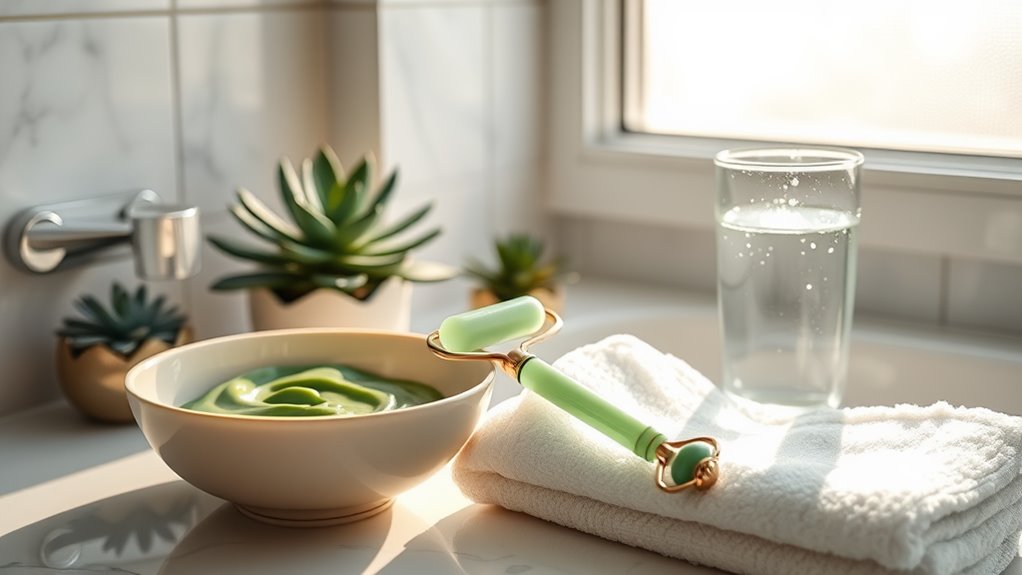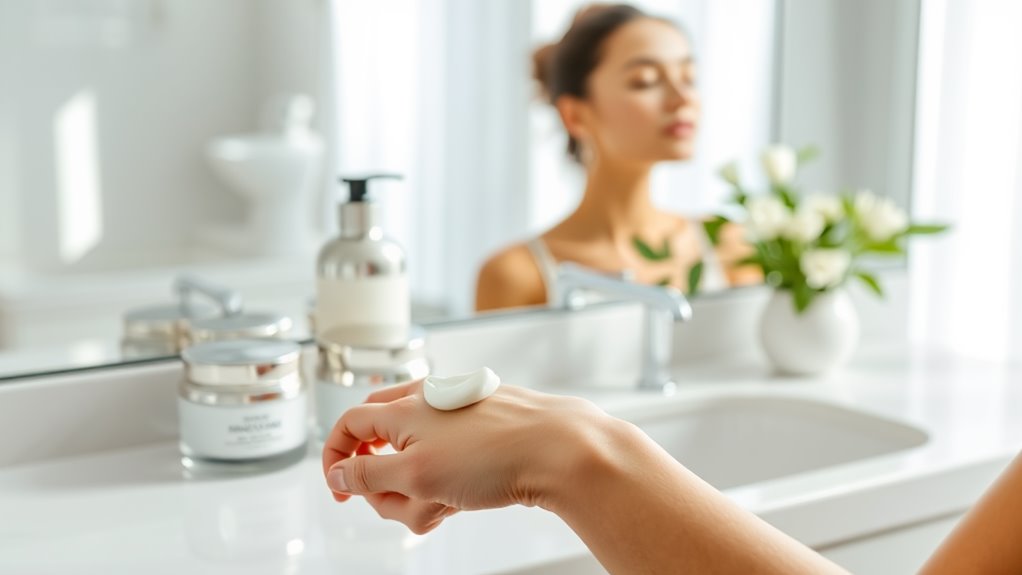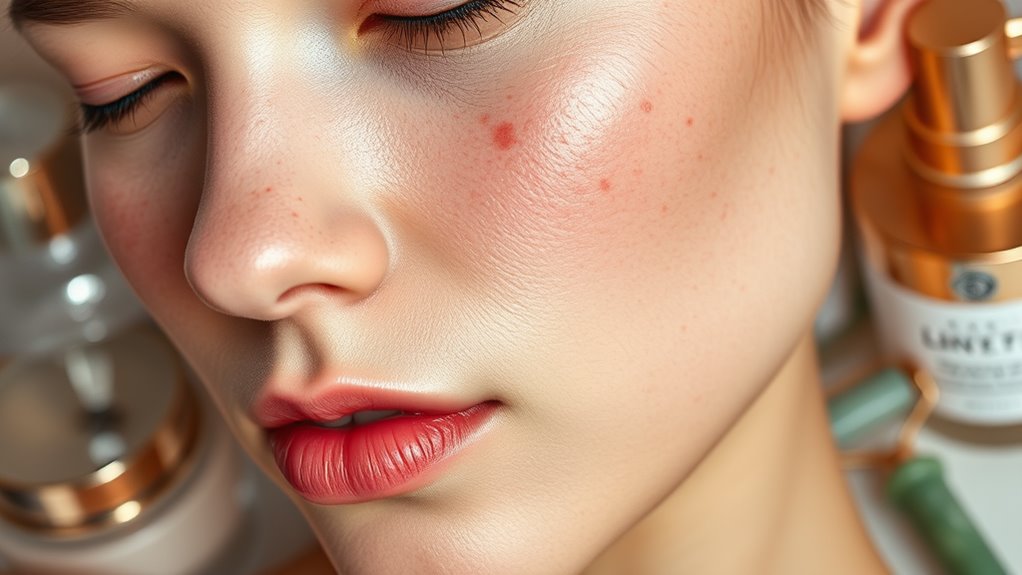How to Reset Your Skin After a Breakout
To reset your skin after a breakout, start with gentle cleansing using a sulfate-free, mild cleanser. Hydrate daily with a non-comedogenic moisturizer to restore moisture and protect your skin barrier. Incorporate light exfoliation for smoother texture and utilize targeted treatments like vitamin C and retinoids for post-acne marks. Always apply broad-spectrum sunscreen to shield against UV damage. By following these steps, you’ll foster a healthier complexion and enhance your recovery process. Explore more strategies to boost your skin’s revival.
Key Takeaways
- Use a gentle, sulfate-free cleanser twice daily to minimize irritation and preserve your skin’s natural oils.
- Apply a non-comedogenic moisturizer to maintain hydration and support skin barrier restoration.
- Incorporate soothing ingredients like hyaluronic acid and niacinamide to reduce inflammation and enhance healing.
- Avoid harsh scrubs; focus on gentle exfoliation with low concentrations of chemical exfoliants to promote cell turnover.
- Protect your skin daily with broad-spectrum sunscreen to prevent UV damage and hyperpigmentation during recovery.
Understand the Aftermath of Breakouts
After a breakout, your skin can often feel sensitive and vulnerable, making it crucial to understand the aftermath.
The post-acne skin recovery phase involves several key factors. First, recognize that inflammation may persist, leading to redness and irritation. This sensitivity necessitates a cautious approach to skincare.
You’ll need to prioritize healing and restoration, focusing on ingredients that promote skin barrier function, such as ceramides and hyaluronic acid. Avoid harsh scrubs or aggressive treatments, as they can exacerbate sensitivity.
Instead, opt for soothing products that support collagen production and improve skin texture. Monitoring your skin’s response is essential; adjust your routine based on how your skin reacts. Incorporating effective strategies for post-acne recovery can further enhance your results.
Mastering these principles will facilitate an effective post-acne recovery process.
Gentle Cleansing for Sensitive Skin
Since your skin is likely to be sensitive after a breakout, opting for a gentle cleansing routine is essential for effective recovery.
Start by choosing a mild, sulfate-free cleanser that won’t strip your skin of its natural oils. Look for ingredients like chamomile or aloe vera, known for their soothing properties.
Cleanse your face twice daily, using lukewarm water to avoid irritation. Apply the cleanser with your fingertips in a circular motion, avoiding harsh scrubbing. Rinse thoroughly and pat your skin dry with a clean, soft towel.
Avoid products containing alcohol or fragrances, as these can exacerbate sensitivity.
Prioritize hydration post-cleansing by applying a gentle, non-comedogenic moisturizer to support your skin’s healing process. This routine promotes balance and resilience. Additionally, incorporating a gentle cleansing routine helps effectively remove impurities while maintaining skin hydration.
Exfoliation Techniques to Remove Dead Skin
Exfoliating your skin is crucial for removing dead skin cells and promoting a smoother complexion. You can choose between physical exfoliation methods, which involve scrubs and brushes, or chemical exfoliation options, such as acids that dissolve dead skin. Understanding the benefits and techniques of each approach will help you select the best method for your skin type. However, it’s important to be cautious, as over-exfoliating can lead to barrier damage and irritation, compromising your skin’s health.
Physical Exfoliation Methods
When skin feels rough or dull after a breakout, incorporating physical exfoliation methods can effectively remove dead skin cells and promote a smoother complexion. These techniques involve manually sloughing off the top layer of skin, enhancing cell turnover and improving texture.
| Method | Description |
|---|---|
| Scrubs | Use abrasive particles to physically buff away dead skin. Choose gentle formulas to avoid irritation. |
| Brushes | Utilize facial brushes to aid in exfoliation while promoting blood circulation. Opt for soft bristles. |
| Sponges | Konjac or silicone sponges provide a mild scrubbing effect, perfect for sensitive skin types. |
Chemical Exfoliation Options
For those seeking a more advanced approach to skin renewal, chemical exfoliation offers targeted solutions for removing dead skin cells and enhancing overall skin texture.
Common options include alpha hydroxy acids (AHAs), such as glycolic and lactic acids, which dissolve the bonds between dead skin cells, promoting cell turnover.
Beta hydroxy acids (BHAs), like salicylic acid, penetrate deeper into pores, effectively addressing acne and oiliness.
Enzyme exfoliants, derived from fruits, provide a gentler alternative, breaking down keratin without harsh scrubbing.
When incorporating chemical exfoliants, start with lower concentrations, gradually increasing as your skin tolerates.
Always follow with broad-spectrum sunscreen, as exfoliation can increase sensitivity to UV damage.
This systematic approach will ensure optimal results while minimizing irritation.
Hydration: The Key to Skin Recovery
Hydration is crucial for skin recovery after a breakout, as it helps restore moisture and supports barrier repair. By incorporating effective moisturizing practices, you can enhance your skin’s resilience and overall appearance. Understanding the best hydrating ingredients will further optimize your recovery process. Additionally, avoiding common mistakes such as using harsh cleansers can prevent further irritation and dryness.
Importance of Moisturizing
Moisturizing plays a crucial role in your skin’s recovery process after a breakout, as it helps restore the skin’s natural barrier and promotes healing.
When your skin is properly hydrated, it can better manage inflammation and redness, enhancing overall resilience. Adequate moisture levels prevent dryness, which can exacerbate irritation and lead to further breakouts.
Moreover, a well-formulated moisturizer can support the absorption of active ingredients, ensuring that your skin receives optimal benefits from treatments.
It’s essential to choose a non-comedogenic moisturizer that suits your skin type, as this ensures you won’t clog pores while providing necessary hydration.
Regularly applying moisturizer not only aids recovery but also maintains long-term skin health, reinforcing your skin’s defenses against future issues.
Hydration and Barrier Repair
When your skin faces the aftermath of a breakout, maintaining adequate hydration becomes essential for effective recovery. Dehydrated skin can exacerbate inflammation and prolong healing time.
Hydration supports the skin’s barrier function, crucial for protecting against environmental aggressors and preventing moisture loss. By replenishing moisture, you help restore elasticity and reduce the appearance of post-inflammatory hyperpigmentation.
Focus on using non-comedogenic moisturizers that enhance hydration without clogging pores. Regularly applying a suitable emollient aids in maintaining your skin’s natural lipid barrier, promoting faster recovery.
Remember that consistent hydration isn’t just about external products; internal hydration through adequate water intake also plays a vital role. Prioritize both aspects to optimize your skin’s healing process after a breakout.
Best Hydrating Ingredients
To effectively reset your skin after a breakout, incorporating the right hydrating ingredients into your skincare regimen is crucial.
Look for hyaluronic acid, a powerful humectant that attracts moisture, plumping your skin and aiding in barrier repair. Glycerin is another excellent option; it draws water into the skin, enhancing hydration without clogging pores.
Niacinamide not only improves skin texture but also boosts moisture retention, making it ideal for post-breakout recovery. Additionally, consider squalane, a lightweight oil that mimics your skin’s natural oils, providing deep hydration without heaviness.
Lastly, aloe vera offers soothing properties alongside hydration, helping to calm irritation.
Together, these ingredients will support optimal skin recovery and maintain a balanced, healthy complexion.
Targeted Treatments for Post-Acne Marks
Post-acne marks can linger long after the breakout has subsided, causing frustration and concern for many.
To effectively target these marks, consider using treatments containing ingredients like retinoids, which promote cell turnover and enhance collagen production. Retinol is particularly effective as it addresses both acne and signs of aging, making it a versatile addition to your skincare routine.
Alpha hydroxy acids (AHAs) gently exfoliate the skin, helping to fade discoloration and improve texture. Additionally, products with vitamin C can brighten the skin and reduce the appearance of hyperpigmentation.
For more persistent marks, consider incorporating chemical peels or microneedling, which can stimulate deeper skin regeneration.
Always apply sunscreen daily to protect your skin during these treatments, as they can increase sensitivity.
Consistency is key; commit to these targeted treatments for optimal results in your skin’s recovery.
Nourishing Your Skin With the Right Ingredients
Nourishing your skin after a breakout requires a careful selection of ingredients that promote healing and restore balance.
Prioritize formulations containing niacinamide, which reduces inflammation and enhances the skin barrier. Incorporate hyaluronic acid for hydration, ensuring your skin retains moisture without clogging pores.
Look for soothing agents like aloe vera or chamomile to calm irritation. Antioxidants, such as vitamin C, are essential for repairing damage and brightening your complexion.
Additionally, consider peptides to support collagen production, aiding in skin regeneration. Avoid harsh ingredients that can exacerbate sensitivity, such as alcohol or synthetic fragrances.
The Importance of Sun Protection
Protecting your skin from UV damage is crucial, especially after a breakout.
Daily application of a broad-spectrum sunscreen helps shield your skin from harmful rays and prevents further irritation.
Choosing the right protection can significantly aid in your skin’s recovery and overall health.
UV Damage Prevention
While you focus on healing your skin after a breakout, it’s crucial to prioritize UV damage prevention. Ultraviolet (UV) rays can exacerbate inflammation, leading to prolonged redness and hyperpigmentation. By protecting your skin, you limit the risk of skin cell damage and promote a more even recovery.
Opt for broad-spectrum protection, which shields against both UVA and UVB rays, as UVA rays penetrate deep and contribute to premature aging, while UVB rays cause sunburn. A high SPF is essential, especially during peak sun hours.
Additionally, consider wearing protective clothing and seeking shade to further minimize exposure. Remember, effective UV damage prevention is integral to achieving optimal skin health and enhancing your post-breakout recovery.
Daily Sunscreen Application
Daily sunscreen application is essential for maintaining skin health, especially after a breakout. UV exposure can exacerbate inflammation and hyperpigmentation, hindering your skin’s recovery process.
Applying sunscreen daily creates a protective barrier, reducing the risk of UV-induced damage and promoting optimal healing. It’s crucial to choose a formula that suits your skin type, ensuring it doesn’t clog pores or cause further irritation.
Apply sunscreen generously to all exposed areas, and reapply every two hours, particularly if you’re outdoors. Integrating this step into your skincare routine reinforces your commitment to skin health.
Choosing Broad-Spectrum Protection
When selecting sunscreen, choosing a broad-spectrum formula is crucial for effective sun protection.
Broad-spectrum sunscreen shields your skin from both UVA and UVB rays, which can cause premature aging and increase the risk of skin cancer. UVA rays penetrate deeply, leading to collagen breakdown and skin damage, while UVB rays primarily cause sunburn.
You should select a product with at least SPF 30 for optimal protection, and apply it generously to all exposed skin. Reapply every two hours, or more frequently if swimming or sweating.
Additionally, consider incorporating antioxidants into your skincare routine, as they can help mitigate sun damage.
Adjusting Your Skincare Routine
Adjusting your skincare routine after a breakout is crucial for promoting healing and preventing future flare-ups.
Start by simplifying your regimen; focus on gentle, non-comedogenic products. Cleanse your skin twice daily with a mild, sulfate-free cleanser to remove impurities without irritating your skin.
Incorporate a treatment containing salicylic acid or benzoyl peroxide, applying it directly to affected areas. Moisturize daily with a lightweight, oil-free moisturizer to maintain hydration without clogging pores.
Avoid harsh scrubs and exfoliants, as these can exacerbate irritation. Lastly, consistently apply a broad-spectrum sunscreen to shield your skin from UV damage.
Monitor your skin’s response and adjust the frequency of active ingredients as needed to minimize irritation while promoting recovery.
Diet and Lifestyle Changes for Clearer Skin
Incorporating diet and lifestyle changes can significantly enhance your skin’s appearance and health.
Prioritizing certain foods and habits can help you achieve clearer skin and restore balance. Here are key adjustments to consider:
-
Hydrate: Ensure you drink adequate water daily to maintain skin moisture and flush out toxins.
-
Nutrition: Focus on a diet rich in antioxidants, healthy fats, and vitamins, such as fruits, vegetables, and omega-3 fatty acids, to nourish your skin from within.
-
Stress Management: Implement stress-reduction techniques like meditation or yoga, as stress can exacerbate breakouts.
When to Seek Professional Help
If your skin remains problematic despite diligent care and lifestyle changes, it may be time to consult a professional. Persistent acne, severe redness, or cystic lesions indicate that over-the-counter treatments mightn’t suffice.
A dermatologist can assess your condition and recommend targeted therapies, such as prescription medications or advanced treatments like chemical peels or laser therapy.
Additionally, if you experience emotional distress due to your skin issues, seeking help is crucial. A professional can provide not just medical solutions but also support tailored to your unique skin type and concerns.




